
Photo credit, PIANO PRODUCTIONS
On June 8, 1983, police in Kansas, United States, found a woman in a church, covered in dirty clothes and looking confused.
The woman said a few words that they didn’t understand. They questioned her in English, but communication was not possible. No one knew what she was saying and she ended up losing her freedom for the next 12 years.
Rita Patino Quintero, that’s her name, is a Raramuri (Tarahumara) indigenous person from Mexico.
That day, she took refuge in the basement of the Methodist temple in the town of Manter, in western Kansas, United States.
She was taken to a police station, where she beat an officer who tried to clean her, says Mexican filmmaker Santiago Esteinou.
He is the director of “The Woman of Stars and Mountains,” a documentary about Rita that premiered in April 2024.
Living in nature
The director began filming in 2016, but the project was not completed until 2022.
“I didn’t get sick. I feel very good living with nature,” Rita says in the film. She speaks in her native language, Raramuri, while looking out at the mountains of her home state of Chihuahua, a state in northern Mexico where the indigenous Raramuri people live.
Raramuri means “light runners” and comes from “rara”, meaning foot, and “muri”, meaning light.
For the Raramuri, running has important social and cultural significance. They live on the slopes of the Sierra Tarahumara, whose complex topography requires them to avoid obstacles, cross streams and climb mountains.
But in Kansas, Rita would have had to contend with drier and colder conditions than in her home state.
This led to her being interned for 12 years in a psychiatric institution in the United States.
Language barrier
Rita only spoke fluent Raramuri.
In the Kansas court system and at the hospital, there were no translators. Rita didn’t understand what was happening around her and why she was locked up.
The official translator didn’t even understand his language.
“They took her to court and a judge concluded that she was not mentally competent, that she was a danger to herself, and so they took her to a psychiatric hospital,” explains Ms Esteinou to BBC Mundo.
The rest of his life was marked by exclusion, medical violence, institutional bureaucracy and loneliness.
Photo credit, PIANO PRODUCTIONS
Who was the real Rita?
Rita was a woman surrounded by myths and mysteries.
She was a shepherd, midwife, herbalist, craftswoman, washerwoman.
Rita did a lot of things, according to Esteinou’s documentary, in which her sister-in-law, her niece and several of her neighbors were interviewed.
Rita, said to have been born in 1930, was originally from Piedras Verdes, in the state of Chihuahua, and later lived in the Cerocahui region, in the municipality of Urique.
She had a partner and a son, according to the director.
He also describes her as “a rich woman” in her community, as she had a large flock of sheep.
But one day everything changed and Rita became “feared and unwanted”.
Her flock was stolen and her neighbors accused her of murdering her husband, which was never proven.
“What happened was that they treated her very badly. It was said that she had fought with her husband, that she had beaten and killed him,” said Procopio Mancinas, a neighbor of Urique who lived near Rita and who participated in the film.
“Rita Patino did not kill Jeronimo Renterias. Rita Patino had her goats, her blankets, her sheep stolen,” he continues.
Esteinou’s research failed to find any public records of his partner’s death in Chihuahua.
It was also believed that she was the victim of some sort of “magic spell”.
In reality, according to Ms. Esteinou, Rita suffered from a disability.
She had speech problems and began wandering with her son. Her community began to look at her with fear. Neighbors say she wasn’t welcomed anywhere.
“Some people didn’t want her; when she arrived, they closed the door in her face. People said she wanted to kill them. But she was hungry and wanted to eat,” Mancinas added.
Following everything she experienced and what was said about her, the authorities took her son away from her, says the director.
Why she left Mexico and how she got to Kansas remains a mystery, Esteinou said. Rita is believed to have walked from Mexico to Kansas.
Photo credit, PIANO PRODUCTIONS
Freedom
The court initially ordered that the woman be admitted to a psychiatric hospital for three months.
His condition would be assessed again at the end of this period.
However, the court-appointed lawyer never appeared before the judges.
He was also unable to communicate with her due to the lack of translators.
At the time, medical staff said they had no idea where the patient was from, making contact with her family members difficult.
Months passed and turned into years.
Rita was unable to speak, she was alone and far from home.
She was treated without a concrete diagnosis due to language barriers.
“I see many forms of discrimination and violence. In Rita’s case, many elements come together. She is an indigenous woman who does not speak English, poor, migrant and probably disabled,” explains Ms. Esteinou.
It took ten years for the situation to change.
The Kansas Advocacy and Protective Services organization, now the Disability Rights Center of Kansas, decided in 1994 to re-examine the cases of patients who had been at the hospital for more than five years.
For Rita, the entity appointed a lawyer, Toria Mroz.
“One of the first things we did was review their medical records. At a very early stage in the documentation, there was a reference to the fact that she was from Chihuahua and that she was an indigenous Tarahumara “, explains Toria Mroz in the documentary.
“It was in her medical records from the beginning of her stay. Even so, ten years had passed and she was still there. They kept saying, ‘We don’t know where she comes from or what language she speaks,’” she adds.
The disability organization sued the hospital and more than 30 of its employees. She demanded $10 million for the damages she suffered.
The legal process posed its own problems, as Rita could not testify in court.
At the time, Esteinou says, there was only one psychiatrist who could understand raramuri (tarahumara).
Rita was released and arrived in Mexico in 1995, but the case continued until 2001. The case was eventually resolved through mediation.
Rita received compensation of $90,000, of which $32,641 was paid to the NGO that helped her.
The rest of the money was to be used to help Rita in her country.
Photo credit, PIANO PRODUCTIONS
Poor but “happy”
Rita continues to live in poverty.
“The court created a trust and appointed a nun named Beatriz Zapata, chosen by the NGO, as administrator of Rita’s property. For about two years, she started giving her about $300 a month, then gave her $6 000 dollars in one go. Then the nun disappeared with the money,” explains the filmmaker.
For several years, the nun used the money for herself. The court was only able to recover $10,000 from the nun.
Two new directors have been appointed. They charged $1,000 a year to run the trust. Both claimed they couldn’t find Rita anywhere.
Ten years later, the money is gone.
Rita is the only publicly known victim of medical neglect due to a lack of communication from Latin America, but many other indigenous women in North America have experienced similar problems.
Rita Patino died in 2018. After her death, her family and community held a “celebration.”
The Raramuri believe that honoring the dead with a festival helps them move on to the next plane of existence, which is where it originated: the stars that illuminate the mountains of the Sierra Tarahumara.
During her stay in Mexico, Rita sang and danced, but she also led a self-centered life,” recalls Mr. Esteinou.
“I am very happy to be here [dans mon pays] “, Rita told Esteinou during one of their meetings.





